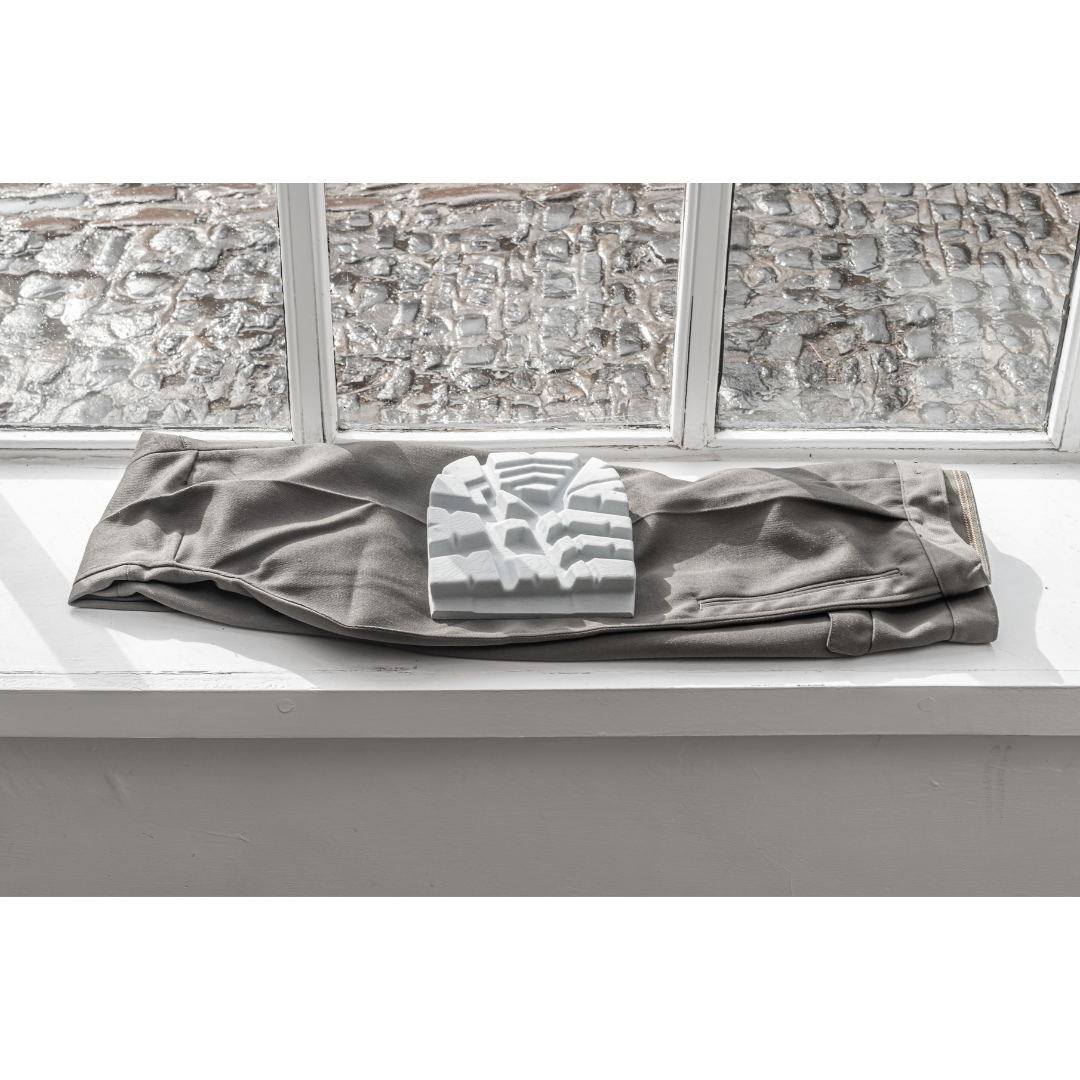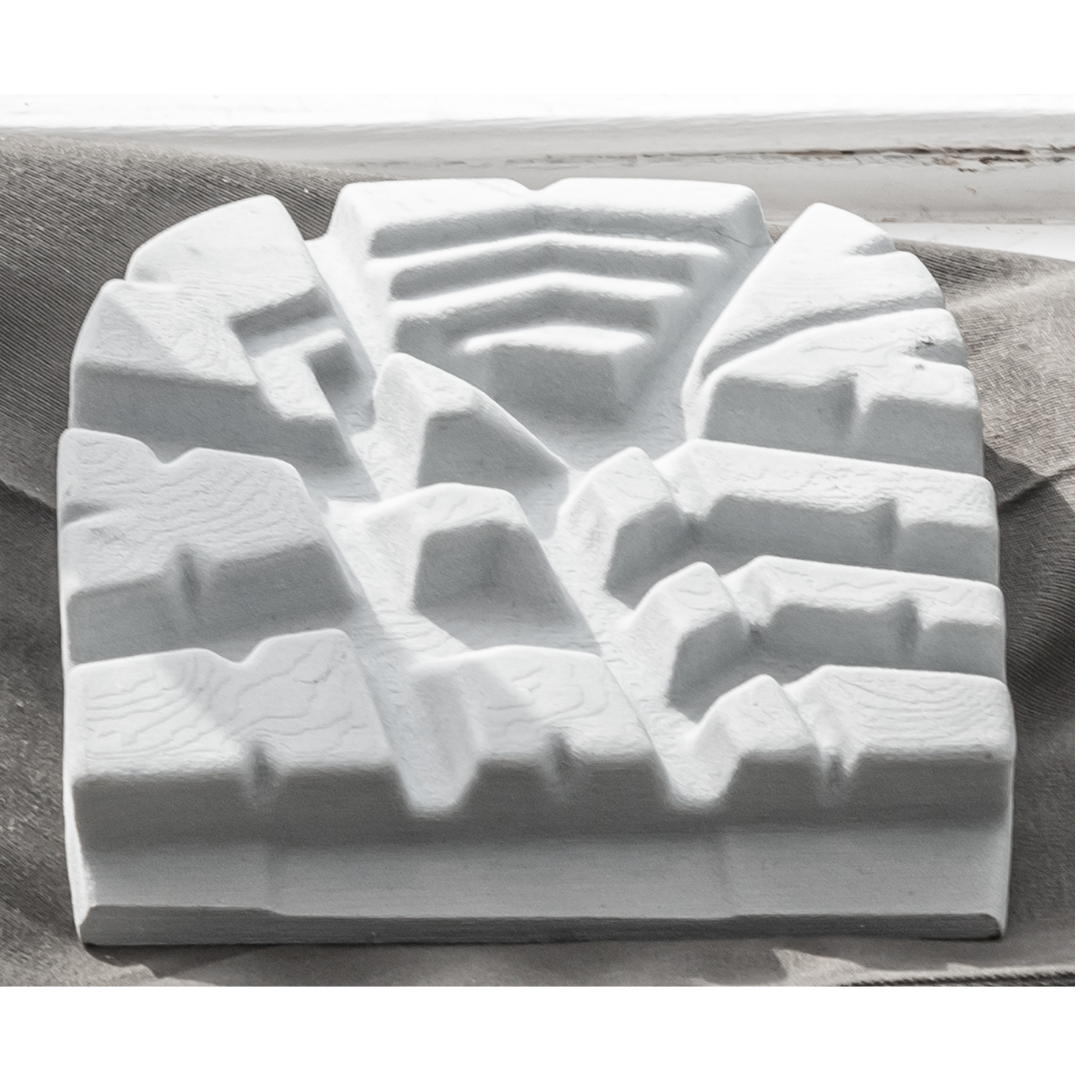





Close Considerations
3D printed boot sole with anthropometric deviation: This work features a 3D printed replica of a boot sole exhibiting significant deviations from a standardised anthropometric model. This deviation serves to emphasise the symbolic power of the object.
Desaturated textile with gypsum plaster: It combines desaturated fabric of beige colour and a subtle sheen, with a grey boot sole sculpture composed of gypsum plaster. The surface texture of the plaster is smooth and created with contemporary technology, which contrasts with the comparatively coarser texture of the old fabric from an older era.
WWII Nazi uniform trousers: The trousers from World War II Nazi uniforms, though harbour a nefarious domineering effect, is the softer and more vulnerable material in this work. while the 3D printed object by the artists of an overemphasised boot sole heavily sits atop, suggesting a reduction of the former by the latter by being placed underfoot.
Quantified boot sole placement (angle/contact area): The artwork's presentation is integral to its discourse, with the boot placed atop the folded trousers either standing or lying down. When stood up, it even resembles a tombstone on the Nazi trouser, and lying down resembles a foot crushing down, which also hints at fetish practices.




Process
Quantitative Analysis of Uniform Design: Papandreopoulos's process begins with historical uniform reference books and catalogues. These resources provide a basis for analysis of uniform designs, involving measurement and comparison of features like colour, fabric type, silhouette, and ornamentation across various cultures. The results were explored in the context of cultural attitudes towards masculinity.
Digital Prototyping: Following an experimental selection process, a specific design element was chosen for initial development focusing on military footwear. Papandreopoulos then employed computer-aided design (CAD) software to generate sketches visualising its chosen element.
Rapid Prototyping and Scaling: Leveraging 3D scanning technology, a high-fidelity digital model was captured of a real military boot. This digital model was then rendered through 3D printing in a physical enlarged replica of the boot sole, occupying the space intended for two standard boots.
Artefact Sourcing: To complete the work, Papandreopoulos conducted an exhaustive search for a pair of trousers that precisely aligned with his mental design. This search encompassed both physical antique stores and online marketplaces. The most suitable pair was of WWII-era Nazi trousers found online.




References
Military Attire: Papandreopoulos's work utilises historical uniform reference books and catalogues as a source for the semiotic analysis of military attire across various cultures. This analysis delves into the symbolic meanings embedded in different uniform elements, enabling an exploration of how cultures use clothing to construct and communicate power.
Authoritarian aesthetic discourse: Papandreopoulos’s monumental, banal objects reference the historical practice of using scale to reinforce power. He has mentioned the colossal pharaoh statues of ancient Egypt, where size directly correlated with a ruler's authority, and more recently, collectivist regimes like Nazi Germany and the Soviet Union employed oversized sculptures of idealised bodies, to overwhelm viewers and instil awe, reinforcing the state's supposed invincibility, right to control as well as to direct citizens’ aspirations.
Tom of Finland’s erotic deviance: Papandreopoulos identifies an aesthetic parallel between the exaggerated masculinity depicted by the collectivist regimes of Nazi Germany and the Soviet Union and Tom of Finland's work which directly deals with their sexual appeal, which the former was fundamentally against. Tom of Finland's work utilises extreme versions of masculinity in uniforms, blurring the line between art and pornography. This reference presents masculinity as a potentially transgressive concept as an individualised erotic deviance in its own right.
Military conscription: A lot of Papandreopoulos’s art practice draws influence from his experience in the Greek military. This experience sharpened his observations of symbols used to establish and reinforce hierarchies and power structures. These symbols can be observed in the imposition of stoic aesthetics, adherence to austerity, enforced uniformity, and emphasis on order. Notably, these elements extend beyond the military context, influencing civilian life through state and corporate control mechanisms.
Samuel Beckett’s examination of disoriented masculinity: The exhibition title originated from Samuel Beckett's short story titled "Echo's Bones," which explores themes of violence and manhood. The regimented life depicted in Papandreopoulos's "Echo's Bones" exhibition, mirroring Beckett's characters in Theatre of the Absurd plays, reflects a potential loss of identity. This suggests a parallel between the disorientation experienced by soldiers in a highly structured environment and the struggles faced by contemporary men grappling with traditional notions of masculinity.
Francis Bacon’s examination of power: By analysing the connections between Samuel Beckett's penultimate work and Francis Bacon's late paintings, a link can be established with Papandreopoulos's practice. All three artists explore the nature of masculinity, portraying it as a constantly shifting concept characterised by doubt and complexity. Their work suggests that male identity is not fixed but rather allows for fluidity and the potential for transformation.


